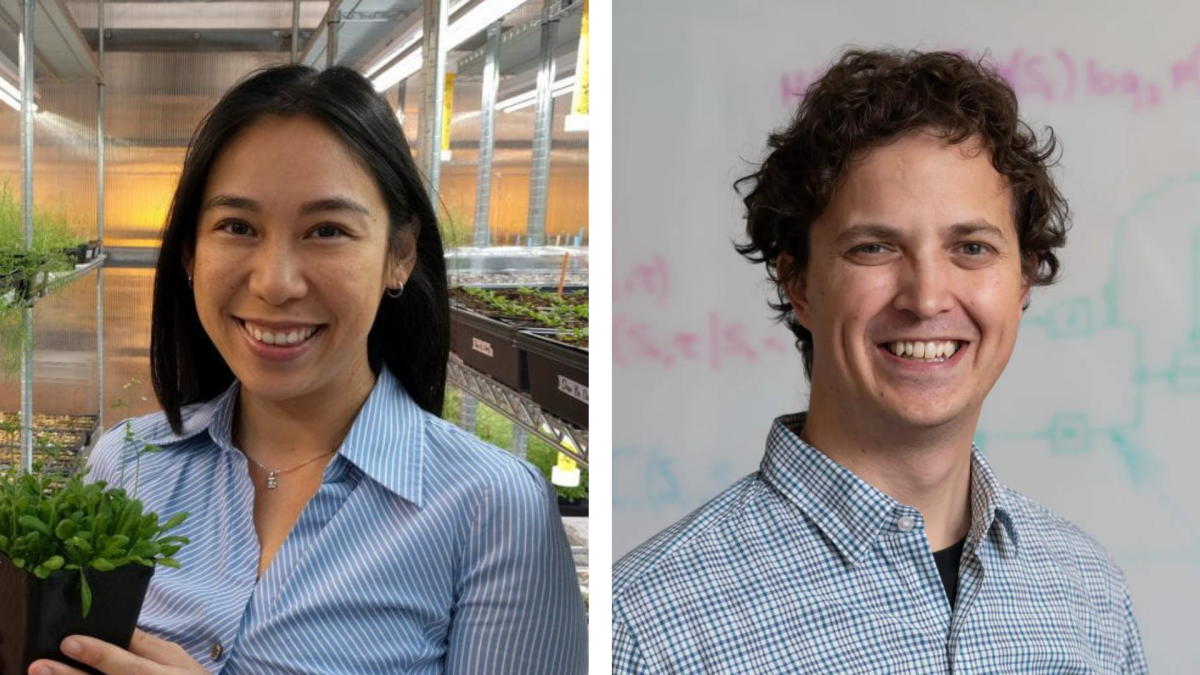By: Selena Langner (sperrin6@gatech.edu)
Thursday, 18 May 2023

Two Georgia Tech Professors, Lily Cheung and Simon Sponberg, have been awarded prestigious Curci Grants, which will fund cutting-edge research in their fields. The Shurl and Kay Curci Foundation supports science-based research striving for the advancement of a healthy and sustainable future for humans.
“The Curci Foundation funds research that’s just emerging, that’s on the edge,” Sponberg says. “Part of the goal is to develop fundamental knowledge that will seed all sorts of future research.”
Cheung’s research has the potential to improve medical treatments — including many cancer treatments — and also to help create plants that are more resilient to climate change, which could help feed communities of the future.
Sponberg’s research into agile movement also has medical applications — potentially changing the way we approach physical therapy for degenerative diseases — as well as a number of other applications, including building better robots.
Lily Cheung: Molecular Biology to Feed the Future
 “My lab works on transporters,” Cheung, an assistant professor in the School of Chemical & Biomolecular Engineering explains. “They’re the proteins on the surface of the cell, and they let things in and out.” Cheung describes them as the gatekeepers or ‘bouncers’ of the cell. While Cheung usually works with plant transporters, her Curci project will explore if the techniques her lab has developed to study plant transporters could be applied to transporters demonstrating pleiotropic drug resistance, also known as PDR.
“My lab works on transporters,” Cheung, an assistant professor in the School of Chemical & Biomolecular Engineering explains. “They’re the proteins on the surface of the cell, and they let things in and out.” Cheung describes them as the gatekeepers or ‘bouncers’ of the cell. While Cheung usually works with plant transporters, her Curci project will explore if the techniques her lab has developed to study plant transporters could be applied to transporters demonstrating pleiotropic drug resistance, also known as PDR.
PDR transporters are a cell’s defense system, and usually, PDR transporters pump things out of the cell that make the cell sick. This includes some cancer drugs and antibiotics, which hinders the effectiveness of the medication.
“In medicine, if we’re trying to kill the cell, we actually want the drugs to stay inside,” Cheung explains, “so knowing the rules for what PDR transporters recognize could be helpful. We want to make drugs that they don’t recognize, so the drugs stay in the cell and do their job. The goal of this project is to see if we can identify the rules that they use.”
“It’s a lot of molecular biology,” Cheung continues. “We’re trying to prove our methods with a transporter called PDR5 from yeast that is known to export certain antibiotics. We’re going to attach a fluorescent protein to it to make biosensors.” If the transporter is active, there should be some level of fluorescence. If the transporter is inactive then there should be no fluorescence. After that, Cheung’s team will make a chemical screen — a method of putting different drugs on the cells — and determine if they can see a change in fluorescence for each drug.
“This will be a little different from the standard way in which pharmaceutical companies do screens,” Cheung adds. Most pharmaceutical companies will apply a drug and look for a very easily measurable effect — usually cell death.
“I'm the other way,” Cheung says. “The method I use is called high content screens. Rather than just looking for dead or alive cells, I look at the full view of the cell to see if something is changing.” Cheung’s technique allows for a more nuanced view, letting her see fully if there is any effect after applying a drug.
“We are interested just in the protein at the surface of the cell,” Cheung adds, “but all of these readouts require other things that might also be important. If you don’t take them into account, you might miss something. You might miss positive targets, or you might accidentally identify negative targets.”
Biting Bigger
Cheung hopes that the project will enable machine learning techniques downstream that would allow researchers to define drugs for a particular kind of protein. In a recent study that Cheung published earlier this year, she used both a chemical screen and a computational screen, leveraging a machine learning model to look at the features of molecules with positive and negative results, and then tested the machine learning model’s ability to predict chemicals that might bind.
“We predicted 12 molecules that were potentially binders and five of them turned out positive, which is a fantastic number in the field of drug screening,” Cheung says. “We had a very good predictive model — in part because we started with very good experimental data. But the approach overall, the whole pipeline works in theory.”
While the first experiment was done on a relatively well-known sugar transporter, now the team plans to apply the computer learning model to a larger, more complicated protein. “We're jumping from that relatively easy problem into this more complicated system. There are a lot of downstream effects that could obscure our results, so we are biting bigger,” Cheung adds.
Putting a Plant in a Computer
While there are a number of human health applications, Cheung stresses that her work is broadly applicable. “I think th e first thing you need to do when you're trying to see how a system works is to list out all the parts and all the interconnection between the parts," she says. "This research is going to hopefully take us in that direction.”
e first thing you need to do when you're trying to see how a system works is to list out all the parts and all the interconnection between the parts," she says. "This research is going to hopefully take us in that direction.”
By leveraging computer learning, Cheung is hopeful that experiments might one day be carried out on a computer rather than in a lab. “In general, I consider myself a systems and synthetic biologist,” Cheung explains. “I would really like to have a plant in a computer and do experiments computationally where we have every possible chemical reaction coded. It’s very ambitious, but that was always my dream.”
For Cheung, this means the ability to help plants become more resilient in our changing climate. “We do hope to understand how plants grow and develop, with the goal of making plants that can grow more while needing less. That's more food for people.”
Simon Sponberg: Uncovering the Science Behind Coordinated Movement
 “My lab has been seeing changes in how we understand how nervous systems control signals to execute agile movements,” Sponberg, a Dunn Family Associate Professor in the School of Physics and School of Biological Sciences, says. “We have to think of the nervous system as a conductor of an orchestra. Precise, coordinated timing of notes between muscles makes the orchestra work.”
“My lab has been seeing changes in how we understand how nervous systems control signals to execute agile movements,” Sponberg, a Dunn Family Associate Professor in the School of Physics and School of Biological Sciences, says. “We have to think of the nervous system as a conductor of an orchestra. Precise, coordinated timing of notes between muscles makes the orchestra work.”
Neurons use action potentials — known as spikes— to coordinate movement, like running or flight. The muscles translate those spikes into smooth changes in force. Scientists have recorded these spikes and can listen to them, where they sound like a series of percussive beeps, and the speed of those beeps is what controls the movement, like a drummer in a band.
However, fast-twitch, agile movements (like swimming through waves or pivoting on a basketball court) are much more dynamic. “We’ve known that this timing is really important, but we haven’t known how it’s done across many muscles,” Sponberg explains. “That’s the novel part here — the coordination across many muscles.”
“In a lot of these systems, the last ten to fifteen years of research shows that this precise pattern of spikes is really important for controlling forces and coordinating movement,” Sponberg says. “The brain isn’t just turning up and down the rate of spikes, it’s also controlling the pattern of the blips.” This is like the drummer playing different rhythms or beats at the same speed.
Sponberg’s lab is looking for what he calls “coordination motifs” — patterns in the way spike timing events play out — in order to reveal the full role of these events in coordination.
There are three key challenges to studying this:
- First, the team needs to be able to observe a rich, sophisticated movement.
- The team also needs to be able to observe the movement fully, and be able to observe the full nervous system interacting with the movement.
- Finally, the system needs to be large enough that it is observable easily.
But something does check all of three boxes: a large group of moths called hawk moths, primarily a species Manduca sexta.
Extraordinary Invertebrates
 “We like to study insects because they’re extraordinary in their ability to move around the planet,” Sponberg explains. “They operate in almost every area of the planet. They have sophisticated movements — they can fly, hop, jump, can feed from flowers in the wind, and they can do it all during the night.”
“We like to study insects because they’re extraordinary in their ability to move around the planet,” Sponberg explains. “They operate in almost every area of the planet. They have sophisticated movements — they can fly, hop, jump, can feed from flowers in the wind, and they can do it all during the night.”
The moths Sponberg’s team studies can take up to 28 turns a second to feed from a flower, exhibiting incredible agile motion, even though their brains are much smaller than a human brain. This dynamic movement partnered with an accessible, compact nervous system makes them ideal for study.
By using small electrical wires, the team can monitor each movement the moth makes, and can read out the electrical systems using electrodes. If the body is an orchestra, “it’s like having complete access to the sheet music,” Sponberg says. “We can use these systems to explore the strategies animals use to do this very precise, thousandth-of-a-second coordination between muscles.”
From Recovery to Robots
Sponberg’s work could have applications for rehabilitation and combatting neurodegenerative diseases with physical therapy. “We know how to intervene to aid slow movement, but rehabilitating for complex, agile dynamic movement is difficult because we don’t know how it’s all coming together,” S ponberg adds.
ponberg adds.
But, the applications are also much vaster than that. For example, researchers could apply Sponberg’s findings to the design and control of small agile robotics. “We have pretty good really tiny robots at the nanometer level and at the meter level, but at the one-centimeter scale, it's really difficult to design those robots. Giving them both power and control is difficult. Learning how these moths do it is a really good analog,” he says.
Sponberg also points toward achieving the multifunctionality that animals have — that is, being able to use the same components for multiple functions — like using a limb both to swim and to hunt for food.
Another thing Sponberg is looking forward to? The interconnected nature of his lab’s broad-reaching research. “One of the things that’s really cool right now is that we just started a new multi-university grant that’s funded by the Air Force,” he says. “That project is focused on understanding how animals parse complex sensory inputs and make decisions. Animals are really good at pulling out the right information.”
“I’m interested in the interface between this sensory world and the precise motor behavior we’re studying with the research funded by the Curci Grant,” Sponberg adds. “I’m excited to see where these two meet.”


